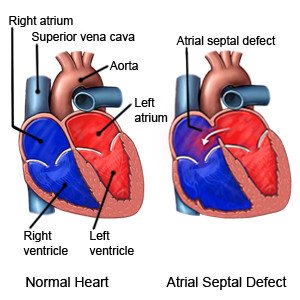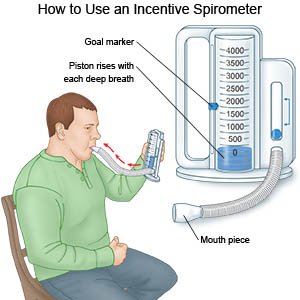Atrial Septal Defect Repair
Medically reviewed by Drugs.com. Last updated on Jun 30, 2025.
What do I need to know about an atrial septal defect (ASD) repair?
An ASD repair is used to close a hole in the septum (wall) between the upper chambers of your heart. The upper chambers are called the right atrium and the left atrium. An ASD repair can be done through open heart surgery or a percutaneous (through the skin) procedure. The type of repair used depends on the size of the ASD and your symptoms.
 |
How do I prepare for an ASD repair?
- You may need blood tests, a chest x-ray, an EKG, or an echocardiogram. The tests will help your provider plan for your surgery or procedure. You may be able to donate your own blood. A family member or a friend with the same blood type as you may be able to donate blood for you.
- Your provider may tell you not to eat or drink anything after midnight on the day of your surgery or procedure. Your provider will tell you which medicines to take or not take. You will be given an antibiotic through your IV on the day of surgery or procedure. This will help prevent a bacterial infection. Tell the healthcare provider about any allergies you have, including to antibiotics or anesthesia.
- Your provider may ask you to take blood thinners if you are having a procedure instead of surgery. Your provider may ask you to start this medicine a few days before your procedure. You may instead be given a blood thinner through your IV on the day of your procedure. This will help prevent blood clots.
What will happen during a surgical ASD repair?
- You will be given general anesthesia to keep you asleep and free from pain during surgery. An IV may be placed in your wrist to monitor your blood pressure. A second IV may be placed in a large vein in your chest or neck to monitor pressures in your heart. Your surgeon will make an incision in your chest. Your surgeon will cut or spread your ribcage apart to reach your heart. Your heart may be connected to a bypass machine. This machine pumps blood to your body and keeps blood out of your heart during surgery.
- Your surgeon will make an incision in your heart. Your surgeon will close the ASD with stitches or a patch. The bypass machine will be stopped and blood will flow through your heart again. The incision will be closed with stitches. Your surgeon may place 1 or more drains in your chest to remove air, blood, or fluid. A bandage will be placed over the area.
What will happen during an ASD repair procedure?
- You may be given general anesthesia to keep you asleep and free from pain during the procedure. You may instead be given medicine to help you relax during the procedure. You will be awake with this medicine, but you should not feel pain during the procedure.
- Your provider will insert a catheter into a vein in your groin. Your provider may use x-ray pictures to help guide the catheter to your heart. Your provider will also use an echocardiogram to look at your heart during the procedure. Your provider will insert a closure device into the ASD with the catheter. Your provider will check to make sure the device is placed correctly and the ASD is closed. Your provider will then remove the catheter and place a bandage over the incision.
What should I expect after an ASD repair?
- Healthcare providers will monitor your blood pressure, heartbeat, oxygen levels, and breathing. They will check your bandage for bleeding or swelling. Do not get out of bed until healthcare providers say it is okay. You may need blood tests, chest x-rays, an EKG, or an echocardiogram before you leave the hospital. These tests will make sure the ASD is closed and your heart is working correctly.
- It may take you several weeks to recover from surgery. During this time you may need someone to help you with laundry, cooking, and activities of daily living (ADLs). ADLs include bathing, dressing, and grooming. Talk to your provider if you do not have someone to help you at home. Healthcare providers may be able to come to your home and help you with ADLs. You may not be able to drive for several weeks. You may want to arrange for someone to drive you to appointments and errands during this time.
What can I do in the hospital to recover from an ASD repair?
- Deep breathe and cough as directed. This will help decrease your risk for a lung infection. Take a deep breath and hold it for as long as you can. Let the air out and then cough strongly. Hold a pillow tightly against your incision when you cough. Deep breaths help open your airway. You may be given an incentive spirometer to help you take deep breaths. Put the plastic piece in your mouth and take a slow, deep breath. Then let the air out and cough. Repeat these steps 10 times every hour.

- Get out of bed when your provider says it is okay. Movement will help prevent blood clots. You may be given exercises to do in bed. Talk to healthcare providers before you get up the first time. They may need to help you stand up safely. When you are able to get up on your own, sit or lie down right away if you feel weak or dizzy. Then press the call light button to let healthcare providers know you need help. You may need to hold a pillow against your incision when you move in and out of bed. This will help decrease pain.
- Wait until your provider says it is okay to eat and drink. You may be given ice chips at first. Then you will get liquids such as water, broth, juice, and clear soft drinks. If your stomach does not become upset, you may then be given soft foods, such as ice cream and applesauce. When you can eat soft foods easily, you may slowly begin to eat solid foods.
What are the risks of an ASD repair?
You may get an infection or bleed more than expected. Your heartbeat may become irregular or you may have heart failure. Your heart muscle or valves may be damaged during surgery. Fluid may collect around your heart or lungs and make it hard for you to breathe. You may get a blood clot in your leg, arm, heart, lungs, or brain. These problems can be life-threatening. The devices used to close the ASD may move out of place. You may need another surgery to fix this. Depending on the damage that your ASD has caused, your heart problems may not get better after repair.
Care Agreement
You have the right to help plan your care. Learn about your health condition and how it may be treated. Discuss treatment options with your healthcare providers to decide what care you want to receive. You always have the right to refuse treatment. The above information is an educational aid only. It is not intended as medical advice for individual conditions or treatments. Talk to your doctor, nurse or pharmacist before following any medical regimen to see if it is safe and effective for you.© Copyright Merative 2025 Information is for End User's use only and may not be sold, redistributed or otherwise used for commercial purposes.
Further information
Always consult your healthcare provider to ensure the information displayed on this page applies to your personal circumstances.
